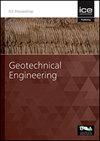Analysis of Long-term Temperatures inside Tunnels during Winter in Gangwon, South Korea
IF 1.7
4区 工程技术
Q3 ENGINEERING, GEOLOGICAL
Proceedings of the Institution of Civil Engineers-Geotechnical Engineering
Pub Date : 2022-04-04
DOI:10.1680/jgeen.21.00026
引用次数: 0
Abstract
Tunnels are among the main components of transport infrastructure systems and as such must be protected against damage. As damage is particularly prevalent in cold climates, this research investigates tunnels in Gangwon Province (the coldest region of South Korea). Herein, the temperatures inside three tunnels, specifically, one short tunnel and two medium-length tunnels, were measured during the winter season using i-button sensors installed on the surface of the tunnel lining at a height of 2 m from the ground. The long-term temperature data as measured in this way were analyzed, indicating that January showed the lowest temperature compared to those in November, December, February, and March. Moreover, the minimum and maximum daily temperatures of air mostly frequently appeared during 3 to 6 AM and 2 to 4 PM, respectively. Also, the highest temperature gradient occurred at a position of 30 m from the entrance or exits. The temperatures inside the tunnels were significantly affected by the external wind, which was induced by the vehicle traffic volume compared to the natural wind direction, the wind velocity, or the presence of rainfall. Hence, tunnel damage caused by frost heaves and freeze-thaw action can be reduced by frequent inspection and evaluations.韩国江原冬季隧道内长期温度分析
隧道是交通基础设施系统的主要组成部分之一,因此必须加以保护,以免受到破坏。由于破坏在寒冷气候中特别普遍,本研究调查了江原道(韩国最冷的地区)的隧道。本文利用安装在隧道衬砌表面距离地面2 m处的i型按钮传感器,在冬季测量了三条隧道内的温度,其中一条为短隧道,另两条为中隧道。分析了用这种方法测得的长期温度数据,发现1月份的温度比11月、12月、2月和3月最低。日最低气温和最高气温分别出现在上午3 ~ 6点和下午2 ~ 4点。温度梯度最大的位置出现在离出入口30m处。与自然风向、风速或降雨量相比,外部风对隧道内的温度有显著影响,这是由车辆交通量引起的。因此,通过频繁的检查和评估,可以减少冻胀和冻融作用对隧道的破坏。
本文章由计算机程序翻译,如有差异,请以英文原文为准。
求助全文
约1分钟内获得全文
求助全文
来源期刊
CiteScore
4.40
自引率
4.50%
发文量
68
审稿时长
3 months
期刊介绍:
Geotechnical Engineering provides a forum for the publication of high quality, topical and relevant technical papers covering all aspects of geotechnical research, design, construction and performance. The journal aims to be of interest to those civil, structural or geotechnical engineering practitioners wishing to develop a greater understanding of the influence of geotechnics on the built environment.

 求助内容:
求助内容: 应助结果提醒方式:
应助结果提醒方式:


